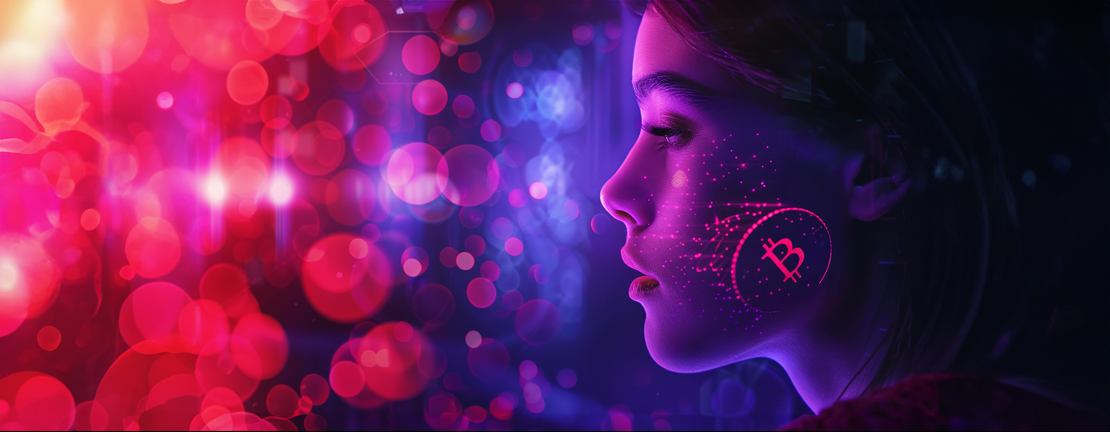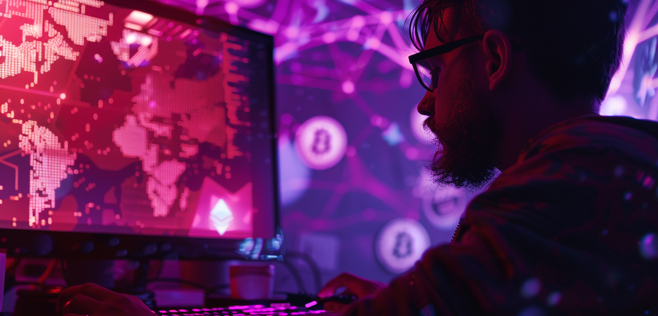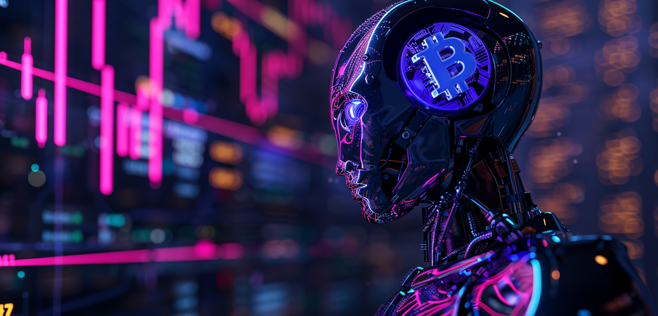Published 17 May 2024
AI and Blockchain: Enhancing Security and Scalability in Cryptocurrencies

Artificial intelligence (AI) and blockchain technology are two transformative forces that have been reshaping various industries in recent years. AI focuses on creating intelligent systems that can learn, reason, and adapt to new information, enabling them to perform tasks that typically require human intelligence. Blockchain, on the other hand, is a decentralized and secure digital ledger technology that enables transparent and tamper-proof transactions, fostering trust and eliminating the need for intermediaries.
The convergence of AI and blockchain has the potential to create innovative solutions that address some of the most pressing challenges in the world of cryptocurrencies, particularly in the areas of security and scalability. By combining the power of AI's data analysis and learning capabilities with blockchain's secure and transparent infrastructure, new possibilities emerge for enhancing the performance, reliability, and resilience of cryptocurrency networks.
In this article, we will explore how AI and blockchain can work together to improve security and scalability in cryptocurrencies, as well as discuss the potential challenges and best practices for integrating these technologies.

AI and Blockchain Security
Blockchain networks and cryptocurrencies, despite their inherent security features, still face various security challenges. Some of these challenges include fraudulent activities, cyberattacks, and network vulnerabilities. Integrating AI with blockchain technology can help address these issues and further enhance the security of cryptocurrency ecosystems.
- Fraud Detection and Prevention
AI-powered algorithms can analyze patterns and trends in transaction data to detect and prevent fraudulent activities. Machine learning models can be trained to identify unusual behavior or transactions that deviate from established patterns, flagging them as potential fraud. For example, AI can help detect and prevent double-spending attacks, where a malicious actor attempts to spend the same cryptocurrency twice.
- Cybersecurity Enhancement
AI can be employed to strengthen the cybersecurity of blockchain networks by identifying and mitigating potential threats. Machine learning algorithms can analyze network traffic and user behavior to detect anomalies and potential cyberattacks. Additionally, AI can help improve the resilience of blockchain networks against distributed denial-of-service (DDoS) attacks by dynamically allocating resources and adjusting network configurations.
- Network Vulnerability Identification
AI can be used to identify and address vulnerabilities in blockchain networks and smart contracts. By analyzing the code and transaction data, AI-powered tools can detect potential weaknesses and suggest appropriate countermeasures. For example, machine learning models can be trained to identify common vulnerabilities in smart contracts, such as reentrancy and timestamp dependence, helping developers create more secure and robust applications.
Several AI-based security solutions have already emerged to address the security challenges faced by blockchain networks and cryptocurrencies. For instance, companies like Chainalysis and Elliptic use AI and machine learning to detect and prevent illicit activities on blockchain networks, while projects like CertiK and Quantstamp employ AI-powered tools to analyze smart contracts and identify potential vulnerabilities.

AI and Blockchain Scalability
Scalability is a significant challenge for many blockchain networks, as the increasing number of users and transactions can lead to congestion, slower transaction speeds, and reduced throughput. AI can be leveraged to address these scalability issues and improve the performance of blockchain networks.
- Consensus Mechanism Optimization
AI can be used to optimize existing consensus mechanisms or develop new ones that are more efficient and scalable. For instance, machine learning algorithms can be employed to predict the behavior of validators or miners, enabling the network to adapt and maintain consensus more effectively. AI can also contribute to the development of hybrid consensus mechanisms that combine the benefits of different approaches, such as proof-of-work (PoW), proof-of-stake (PoS), and delegated proof-of-stake (DPoS).
- Network Architecture Improvement
AI can help design and implement more scalable and efficient blockchain network architectures. For example, machine learning algorithms can be used to optimize the placement of nodes and the distribution of data, reducing latency and improving overall network performance. AI can also contribute to the development of off-chain and sidechain solutions, such as payment channels and state channels, which can help alleviate the burden on the main blockchain network and improve scalability.
- Dynamic Sharding
Sharding is a technique that involves dividing a blockchain network into smaller, independent parts called shards, which can process transactions and smart contracts in parallel. AI can be employed to enable dynamic sharding, where the number and composition of shards are adjusted automatically based on the network's current workload and transaction patterns. This can help ensure that the network remains scalable and efficient, even as the volume and complexity of transactions change over time.
Several AI-based scalability solutions for blockchain networks have been proposed or are currently under development. For example, projects like Harmony and Zilliqa are leveraging AI and machine learning to enable dynamic sharding and improve the scalability of their networks. Additionally, researchers are exploring the use of AI-powered consensus mechanisms, such as Byzantine-fault-tolerant machine learning algorithms, to enhance the scalability and security of blockchain networks.

The Synergy of AI and Blockchain
The integration of AI and blockchain technology has the potential to create a powerful synergy that can benefit various industries beyond cryptocurrencies. By combining the strengths of both technologies, new opportunities for innovation, efficiency, and trust emerge.
- Data Integrity and Transparency
AI relies heavily on accurate and reliable data to generate insights and make predictions. Blockchain's immutable and transparent ledger can provide a secure and trustworthy foundation for AI models, ensuring that the data used is tamper-proof and verifiable. This can lead to improved decision-making and more accurate predictions in various applications, such as fraud detection, risk assessment, and predictive maintenance.
- Trust and Security
Blockchain's decentralized and secure nature can enhance trust in AI systems, as it enables the creation of tamper-evident and auditable records of AI model training, deployment, and decision-making. This can help address concerns around AI bias, accountability, and transparency, making AI systems more reliable and trustworthy for users and stakeholders.
- Decentralized Intelligence
The integration of AI and blockchain can enable the creation of decentralized intelligence networks, where AI models and data are shared and collaboratively improved upon by a community of users. This can lead to the development of more robust and accurate AI models, as well as the democratization of AI technology, making it accessible to a wider range of individuals and organizations.
Beyond cryptocurrencies, AI and blockchain can be combined to address challenges and create new opportunities in various industries, such as:
- Supply Chain Management
AI and blockchain can be used to create more transparent, secure, and efficient supply chains, enabling real-time tracking of goods, automated contract execution, and predictive analytics for demand forecasting and inventory management.
- Healthcare
The integration of AI and blockchain can improve patient data management, enable secure and privacy-preserving data sharing, and support the development of personalized medicine and remote monitoring solutions.
- Finance
AI and blockchain can be leveraged to enhance financial services, such as credit scoring, algorithmic trading, and fraud detection, while also enabling the creation of decentralized financial platforms and services.
Realizing the full potential of AI and blockchain integration requires collaboration and innovation among various stakeholders, including researchers, developers, businesses, and policymakers. By working together to explore new use cases, address technical challenges, and develop supportive regulatory frameworks, we can unlock the transformative potential of these technologies and create a more secure, efficient, and interconnected world.

Challenges and Limitations
While the integration of AI and blockchain holds great promise, there are several challenges and limitations that need to be addressed to ensure successful implementation and widespread adoption.
- Data Privacy
One of the main challenges in integrating AI and blockchain is balancing data privacy and transparency. While blockchain's immutability and transparency can enhance trust in AI systems, it can also raise concerns around data privacy and confidentiality. Developing privacy-preserving techniques, such as homomorphic encryption, zero-knowledge proofs, and differential privacy, can help address these concerns and enable secure data sharing and collaboration.
- Regulatory Concerns
The rapidly evolving nature of both AI and blockchain technologies presents regulatory challenges, as existing frameworks may not be well-suited to address the unique aspects and risks associated with these technologies. Collaboration between industry stakeholders and policymakers is essential to develop clear and supportive regulatory guidelines that foster innovation while ensuring user protection and compliance.
- Technical Complexities
Integrating AI and blockchain technologies can be technically challenging, as it requires addressing issues related to scalability, interoperability, and the integration of diverse data sources. Overcoming these challenges may involve the development of new protocols, standards, and infrastructure to support the seamless integration and interaction of AI and blockchain systems.
- Energy Consumption
Both AI and blockchain technologies can be energy-intensive, particularly in the context of training complex AI models and maintaining consensus in proof-of-work blockchain networks. Developing more energy-efficient algorithms, consensus mechanisms, and hardware solutions can help mitigate the environmental impact and reduce the cost associated with integrating AI and blockchain.
Addressing these challenges and limitations requires a collaborative and interdisciplinary approach, involving researchers, developers, businesses, and policymakers. By working together to develop innovative solutions and address the technical, regulatory, and ethical aspects of AI and blockchain integration, we can unlock their full potential and create a more secure, efficient, and interconnected world.

Best Practices for AI and Blockchain Integration
To successfully integrate AI and blockchain technologies and harness their potential, businesses and developers should follow best practices that ensure a strategic and well-informed approach. Here are some key guidelines to consider:
- Identify the Right Use Cases
Not all problems or applications may benefit from integrating AI and blockchain. Assess the specific needs and challenges of your use case, and determine whether the combination of AI and blockchain can provide significant value in terms of security, scalability, transparency, or efficiency.
- Select Appropriate Technologies
Choose the right AI and blockchain technologies that align with your use case and business objectives. This may involve evaluating different consensus mechanisms, AI algorithms, and platform options to find the best fit for your specific needs.
- Ensure Data Quality
High-quality data is crucial for the success of AI models and blockchain applications. Implement robust data management practices, including data validation, cleaning, and normalization, to ensure that the data used in your AI and blockchain systems is accurate, reliable, and relevant.
- Prioritize Security and Privacy
Address potential security and privacy risks associated with AI and blockchain integration by implementing appropriate measures, such as encryption, access controls, and privacy-preserving techniques. Regularly assess and update your security protocols to ensure ongoing protection against evolving threats.
- Foster Collaboration and Interoperability
Collaborate with other businesses, researchers, and developers to share knowledge, resources, and expertise in AI and blockchain technologies. Promote interoperability between different platforms and systems to facilitate seamless integration and data exchange.
- Stay Informed about Regulatory Developments
Keep track of regulatory developments and guidelines related to AI and blockchain technologies. Ensure that your systems and processes comply with relevant laws and regulations to avoid potential legal and reputational risks.
- Monitor and Evaluate Performance
Regularly monitor and evaluate the performance of your AI and blockchain systems to identify areas for improvement and optimization. Use performance metrics and benchmarks to assess the effectiveness of your solutions and make data-driven decisions.
- Invest in Education and Training
Build a skilled and knowledgeable team by investing in education and training on AI and blockchain technologies. Encourage continuous learning and development to ensure that your team stays up-to-date with the latest trends, tools, and best practices.
By following these best practices, businesses and developers can navigate the complex landscape of AI and blockchain integration and successfully leverage the potential of these transformative technologies to create innovative and value-added solutions.

Conclusion
The integration of AI and blockchain technologies holds immense potential for enhancing security and scalability in cryptocurrencies, as well as unlocking new opportunities across various industries. By combining the strengths of AI and blockchain, we can create more secure, transparent, and efficient systems that address some of the most pressing challenges in today's digital world.
As AI and blockchain continue to evolve, it is crucial for businesses, developers, and enthusiasts to stay informed about the latest developments and innovations in these fields. By keeping up-to-date with the rapidly changing landscape, we can better understand the potential implications and benefits of AI and blockchain integration, and identify new opportunities for collaboration and growth.
As we look to the future, the convergence of AI and blockchain is set to reshape the way we interact with technology, redefining trust, security, and efficiency in an increasingly interconnected world.
Read More




 Get RateX Pro
Get RateX Pro

 25 Apr 2024
25 Apr 2024
